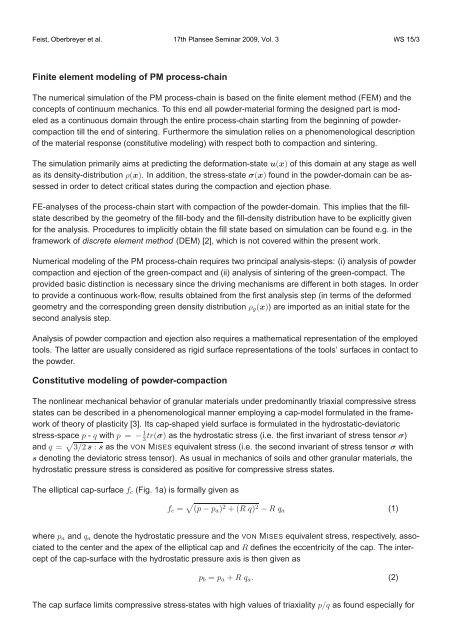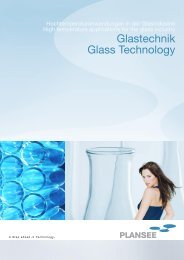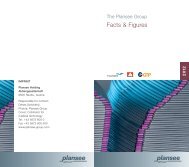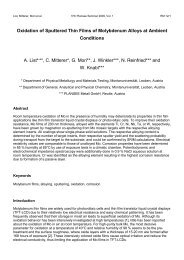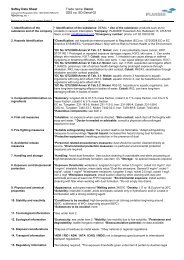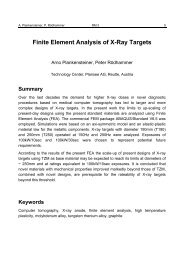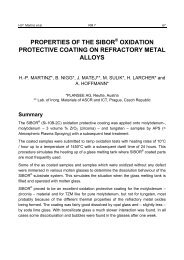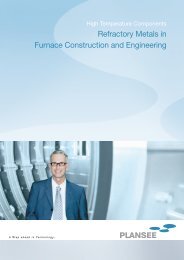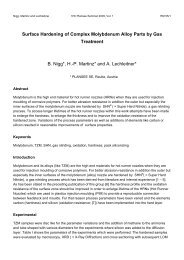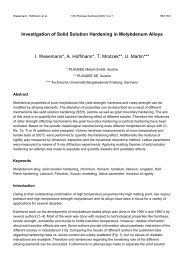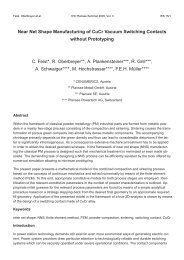Near Net Shape Manufacturing of CuCr Vacuum Switching Contacts ...
Near Net Shape Manufacturing of CuCr Vacuum Switching Contacts ...
Near Net Shape Manufacturing of CuCr Vacuum Switching Contacts ...
Create successful ePaper yourself
Turn your PDF publications into a flip-book with our unique Google optimized e-Paper software.
Feist, Oberbreyer et al. 17th Plansee Seminar 2009, Vol. 3 WS 15/3<br />
Finite element modeling <strong>of</strong> PM process-chain<br />
The numerical simulation <strong>of</strong> the PM process-chain is based on the finite element method (FEM) and the<br />
concepts <strong>of</strong> continuum mechanics. To this end all powder-material forming the designed part is modeled<br />
as a continuous domain through the entire process-chain starting from the beginning <strong>of</strong> powdercompaction<br />
till the end <strong>of</strong> sintering. Furthermore the simulation relies on a phenomenological description<br />
<strong>of</strong> the material response (constitutive modeling) with respect both to compaction and sintering.<br />
The simulation primarily aims at predicting the deformation-state u(x) <strong>of</strong> this domain at any stage as well<br />
as its density-distribution ρ(x). In addition, the stress-state σ(x) found in the powder-domain can be assessed<br />
in order to detect critical states during the compaction and ejection phase.<br />
FE-analyses <strong>of</strong> the process-chain start with compaction <strong>of</strong> the powder-domain. This implies that the fillstate<br />
described by the geometry <strong>of</strong> the fill-body and the fill-density distribution have to be explicitly given<br />
for the analysis. Procedures to implicitly obtain the fill state based on simulation can be found e.g. in the<br />
framework <strong>of</strong> discrete element method (DEM) [2], which is not covered within the present work.<br />
Numerical modeling <strong>of</strong> the PM process-chain requires two principal analysis-steps: (i) analysis <strong>of</strong> powder<br />
compaction and ejection <strong>of</strong> the green-compact and (ii) analysis <strong>of</strong> sintering <strong>of</strong> the green-compact. The<br />
provided basic distinction is necessary since the driving mechanisms are different in both stages. In order<br />
to provide a continuous work-flow, results obtained from the first analysis step (in terms <strong>of</strong> the deformed<br />
geometry and the corresponding green density distribution ρg(x)) are imported as an initial state for the<br />
second analysis step.<br />
Analysis <strong>of</strong> powder compaction and ejection also requires a mathematical representation <strong>of</strong> the employed<br />
tools. The latter are usually considered as rigid surface representations <strong>of</strong> the tools’ surfaces in contact to<br />
the powder.<br />
Constitutive modeling <strong>of</strong> powder-compaction<br />
The nonlinear mechanical behavior <strong>of</strong> granular materials under predominantly triaxial compressive stress<br />
states can be described in a phenomenological manner employing a cap-model formulated in the framework<br />
<strong>of</strong> theory <strong>of</strong> plasticity [3]. Its cap-shaped yield surface is formulated in the hydrostatic-deviatoric<br />
stress-space p - q with p = − 1<br />
3<br />
tr(σ) as the hydrostatic stress (i.e. the first invariant <strong>of</strong> stress tensor σ)<br />
and q = � 3/2 s : s as the VON MISES equivalent stress (i.e. the second invariant <strong>of</strong> stress tensor σ with<br />
s denoting the deviatoric stress tensor). As usual in mechanics <strong>of</strong> soils and other granular materials, the<br />
hydrostatic pressure stress is considered as positive for compressive stress states.<br />
The elliptical cap-surface fc (Fig. 1a) is formally given as<br />
fc = � (p − pa) 2 + (R q) 2 − R qa<br />
where pa and qa denote the hydrostatic pressure and the VON MISES equivalent stress, respectively, associated<br />
to the center and the apex <strong>of</strong> the elliptical cap and R defines the eccentricity <strong>of</strong> the cap. The intercept<br />
<strong>of</strong> the cap-surface with the hydrostatic pressure axis is then given as<br />
(1)<br />
pb = pa + R qa. (2)<br />
The cap surface limits compressive stress-states with high values <strong>of</strong> triaxiality p/q as found especially for


